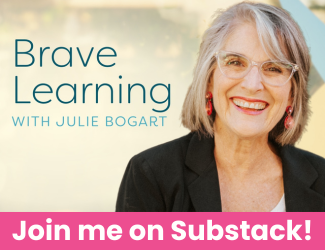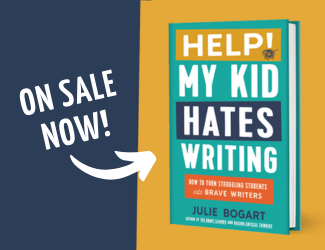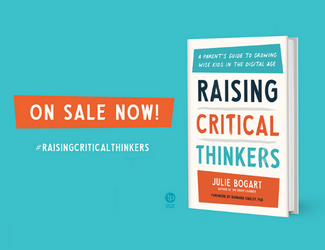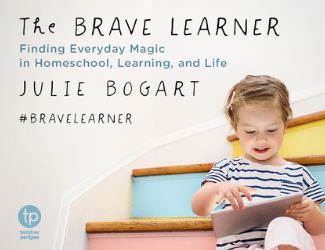Don't expect yr kids to meet yr emotional needs. Meet theirs. One day, they'll try yr tactics on you, testing them for future relationships.
— Julie Bogart (@BraveWriter) September 30, 2013
Archive for September, 2013
Meet their needs, and some day they’ll meet yours
Boredom Is a Red Flag
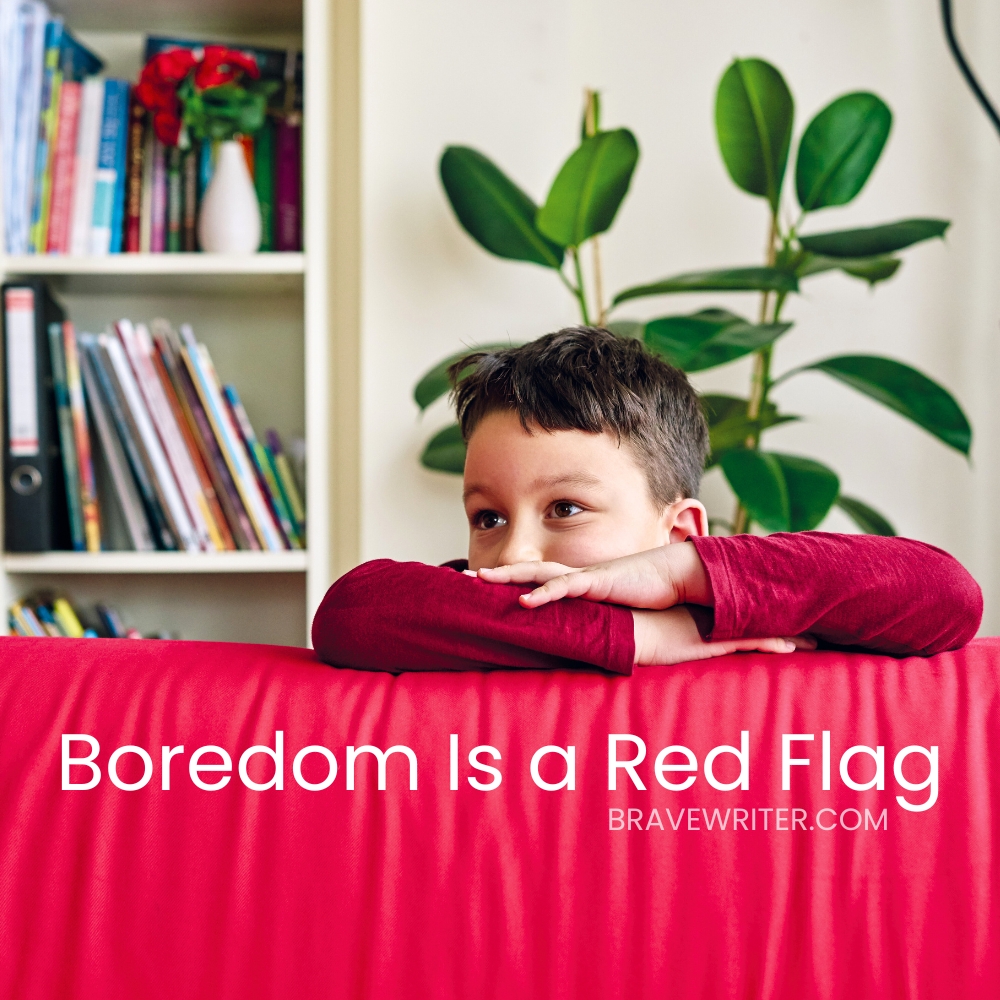
“I’m bored.”
Words no parent wants to hear.
My dad, unhelpfully, used to reply to us that we had no idea how valuable our free time would appear to us as adults, and that we shouldn’t waste it since we’d never get it back.
Like I said: Unhelpful.
In that moment, I was genuinely bored, as a kid with free time. I didn’t know what to do with myself. My declaration was a cry for help (ideas, materials, suggestions, participation). It wasn’t a philosophical musing in need of expansion.
Boredom is a signal!
It’s a sign that something needs to change about the environment or your interactions with your kids. It is not an indictment on a child’s ability to self-soothe or auto-entertain.
Some parenting “experts” suggest leaving your child in a bored condition, as though once bored long enough, stores of creativity will rush forward. The advice goes something like this: “It’s okay for your children to be bored. If they are bored long enough, eventually they will become creative geniuses because they had nothing better to do.”
Only that isn’t what happens. If you leave a child bored long enough, they typically whine louder, get into mischief, or pick a fight! Boredom doesn’t ensure creativity, problem solving, or learning. Deliberately fostering an environment that produces boredom is cruel.
The experts aren’t entirely out of line in their hope that a child without something to do will find something he or she wants to do, and it will be fresh and new. But boredom doesn’t take anyone there.
There’s a difference between “boredom” (a feeling of futility) and “pause” (the let-down after a rush of activity). Sometimes a child is simply recalibrating after a vacation or visit from his best friend or post-birthday party. A soothing “downtime” activity like watching a DVD or taking a bath or going for a walk with the dog may be just the transition needed.
The way to address the “I’m bored” comment that comes from “nothing to do” is not to shame it or blame it. Rather, you want to create “space” for newness, for freshness. It’s okay not to plan all the activities for the day. It’s okay to let children explore their environment in search of something new to do. What isn’t okay is leaving them to search in a tedious, empty-of-possibilities environment. That’s what produces boredom and “I can’t think of anything to do.”
Your job is to keep a home that is flexible enough, well enough stocked, surprising enough (on many occasions, not just once-in-a-blue-moon), and accessible enough to your kids. It should be a home where kid activity is welcomed. It should be a home where messes are freely made.
Like this:
Put an arts and crafts table in the middle of the main room in the house (not the basement, not in a corner of a room no one is in, not in the child’s bedroom). The arts and crafts table ought to be where the family hangs out. It should hold materials like paintbrushes in tin cans, watercolors, finger paints, paper for painting. It should have scissors, sponges, polymer clay, scotch tape, pipe cleaners, markers, pencils, and stencils all in little bins or on trays. Hang out-of-use men’s dress shirts on a nearby hook to wear over clothes to protect your kids from staining their shirts and shorts. The table can be covered in contact paper for ease of wiping messes after they are made. Containers for water to dip brushes ought to be available too. A trash can can be tucked under the table for scraps of cut up paper or used up materials. Art books with real art in them make great models for inspiration, too.
In our family, I mounted a bulletin board right above the arts and crafts table so paintings and drawings could be hung right away. We also strung a clothing line across the room and used clothespins to hang masterpieces.
Clear the coffee table. At bedtime, put out the “new” item you want your kids to find in the morning on the now cleared surface. It might be a new set of jacks, pick up sticks, or a book that teaches knitting with needles and yarn waiting. Perhaps you leave a snorkel and goggles on the table and when the kids wake, you let them know you are off to the beach or swimming pool. Put out a new board game (Sorry, Risk, Stratego, Spinergy, Clue, Life). A stack of beautiful note cards and pens (maybe even calligraphy or fountain pens!) with a list of addresses, stamps, and sealing wax for the envelopes could cause even reluctant writers to send letters to grandparents, aunts, and cousins. Bouncy balls will create a chaos of fun, as will a bigger ball for handball against the garage door. Teach them how to play. Sidewalk chalk for hopscotch—so much fun! Make your own markers out of polymer clay. Buy a book of origami and a stack of the beautiful squares of paper. Make paper cranes!
Invest in technology. Buy the game or camcorder or iPad. It’s the future. It’s worth turning your kids loose to discover how these work. They will show you things to do on your device you didn’t even know were possible. Know that they will break them all eventually. Be prepared for that outcome. Do not “loan” your precious tool to your kids. Get them their own.
Make the kitchen kid friendly. Bored kids often become engaged when they are making real stuff. Food is about as real as it gets. Let them make the lunch or afternoon snack. If you are ambitious, they can do dessert or the entire dinner. Find recipes that are kid friendly (English muffin pizzas, ice cream sundae bar, omelets, hamburgers, shish kabobs, stir fry, cupcakes, wraps, Mexican food, chili). Someone can lay the table with place cards and a centerpiece.
Dress up clothes and face paints: these two together provided untold distractions for my children. What I discovered, though, was that they liked it better if an adult did the face painting because the results were clean and satisfying. They also liked involving me (and a friend who was a lot better at face painting than I was!). We also would say: “Give us a show at ________ o’clock.” That kind of time frame helped the kids to not just play but to know there was a check-in time with the parents too (the kids weren’t being “sent away” because they were annoying, but to produce something to share).
Be the buddy. Play the card game, jump the rope, watch the movie (for the jillionth time), bake the muffins, paint, model, dress up. You deserve to play too. Your kids deserve to have your involvement. The goal isn’t to get them to stop being bored so you can have a break. The idea is to create conditions that lead to self-started entertainment. Sometimes that happens best when you’re a participant.
Lastly, boredom is a fact of life. Kids are notoriously short on patience for the “next thing.” They want to be doing it right now! Suggesting that they clean their rooms is not useful.
Make a big list (with the help of your kids) of all the activities possible in your home that children and teens can do alone. Post the list to the refrigerator and send your children to it to consult when they forget what they can do. Put supplies in obvious places so that they get inspired. Kids don’t find activities in their heads. They find them among the items they encounter in the house. Don’t hide all that good stuff behind cabinet doors!
Make sure there is nothing on the refrigerator list that still needs to be purchased! Nothing worse than getting that perfect idea of what to do only to find out that you are out of paints or batteries.
Not puzzle-solving, but voice-finding
Format writing teaches kids to solve the “puzzle” of the assignment rather than teaching kids to tap into their writing voices. #homeschool
— Julie Bogart (@BraveWriter) September 29, 2013
Brave Writer spotlight: Maya
 Our students are not just Brave Writers, they’re Brave People. Take nine-year-old Maya, for example. She’s making friendship bracelets to raise money for her uncle’s medical treatment. Her mom writes:
Our students are not just Brave Writers, they’re Brave People. Take nine-year-old Maya, for example. She’s making friendship bracelets to raise money for her uncle’s medical treatment. Her mom writes:
Dear Julie,
Since purchasing the Writer’s Jungle and following your tips/tricks, I’ve been thinking about writing in a whole new light. I cannot begin to tell you how Maya has grown in her writing abilities. Not only that, she’s so verbal now. To me, to friends, to strangers, she’s no longer timid. She realizes now that she has a voice. She appreciates direct eye contact and notices right away if she’s getting full attention or not, and she lets me know about it. Thank you for making me understand that conversation is a first step in writing. I never thought of it that way until you showed me the light.
Our relationship has grown so much just by having great conversation. SHE is growing by having conversation. Over the weekend, she expressed an interest in raising funds for her Uncle Josh. (My brother, who has a severe traumatic injury, in need of Hyperbaric Oxygen therapy.) So we went to my mom’s and made a video to start an online fundraising campaign. I don’t think she would have had the courage to do this just a few short months ago. But because of your encouraging and uncomplicated writing advice, she is gaining valuable skills. Skills that I wouldn’t have recognized before. Like organizing her thoughts to make cohesive statements and becoming a confident speaker. I’m sure you can think of many more.
I thought you might like to see the video (silly as it is) and to thank you for your practical, no-nonsense, simple yet profound advice that is turning my little nine year old into a deep-thinker, with compassion and determination. Who would have thought that talking could do all of that?
Thanks again,
Misty
Pick a passion
This year, as you plan, pick an area of interest for yourself. It could be learning how to cultivate African violets (that was mine!) or how to quilt. It could be art history or learning to play acoustic guitar. It might be studying personality types through the enneagram or exploring the skies with a telescope. You might be fascinated by therapies for language impaired kids. You might ache to hike the gorge near your house.
Perhaps you want to become a blogger or start a business organizing people’s homes for them. Maybe you wish you could cut hair or learn Latin. What about geo-caching or running a marathon?
You might paint, pot, or write slam poetry.
You can learn algebra from the ground up, just because you want to prove to yourself that you are smart enough to learn it.
Growing an herb garden so you can make your own pesto, dying wool to knit, sanding the old kitchen table and painting it turquoise blue, joining a fantasy football team online…
Any of these constitute learning that is yours, that engages you with the world around you and the process of learning. Not all of what you do has to have immediate applicability to homeschool, either. You don’t have to pass on what you are learning, though I promise it will bleed into the rest of your lives together.
When you make time for your own learning, you discover what it is to learn—to self-teach. You discover how you evaluate what fosters learning and what constitutes a dead end. You engage a process that teaches you what teaches.
All of you benefit when you become a curious, self-guiding, learner in your own right! Go sign up for that yoga class or enter grad school for history, just because.
Be a labor coach or a La Leche League meeting host.
Bike. Swim. Read the entire Jane Austen canon and then watch all the films that go with it.
Write a novel in a month.
Make your own ice cream.
Take tap lessons.
Hang dry wall.
The world is not just waiting for your kids to grow up. It’s waiting for you too. Get out in it. Explore it. Enjoy it. Live it—with your kids, in front of your kids, for yourself.
Cheers!
Image by Abigail Batchelder













